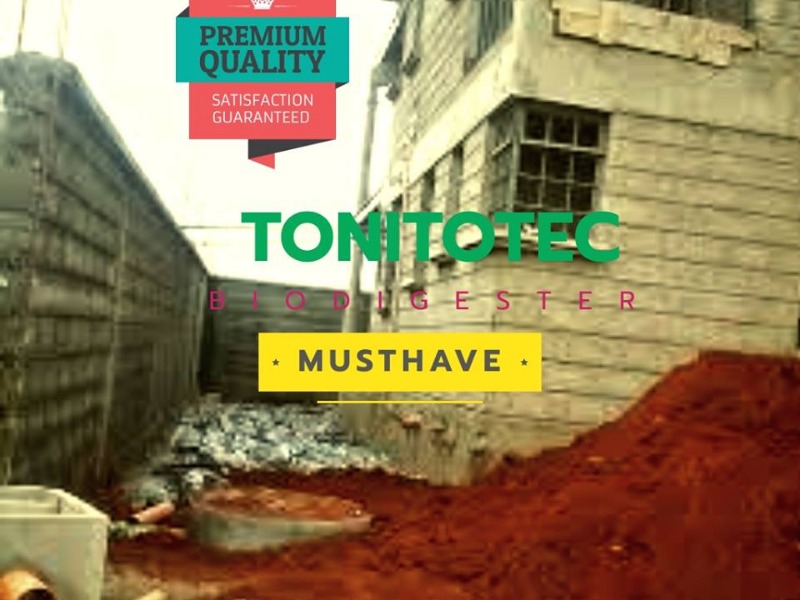- Forum
- categories
- Sanitation systems
- Treatment of wastewater, sludges, organic waste, excreta
- Septic tanks (conventional or upgraded)
- Regular septic tanks vs Biodigester septic tanks
Regular septic tanks vs Biodigester septic tanks
111k views
- favortecwastewatersolutions
-
Less
- Posts: 1
- Likes received: 1
Re: Regular septic tanks vs Biodigester septic tanks
if you are searching for a biodigester in kenya, you have to the right place as am an installer from kenya you can view our website on www.tonito.co.ke
Attachments:
-
 61079543_6...00_n.png
(Filesize: 17KB)
61079543_6...00_n.png
(Filesize: 17KB)
The following user(s) like this post: AjitSeshadri
Please Log in to join the conversation.
You need to login to reply- AjitSeshadri
-

- Marine Chief Engineer by profession (1971- present) and at present Faculty in Marine Engg. Deptt. Vels University, Chennai, India. Also proficient in giving Environmental solutions , Designation- Prof. Ajit Seshadri, Head- Environment, The Vigyan Vijay Foundation, NGO, New Delhi, INDIA , Consultant located at present at Chennai, India
Dear SuSanA Members.
We definitely need to innovate and apply natural principles to sustainable practices.
When an initiative starts to perform to communities, its like a life cycle of a new born baby.. to child.. then an adult.. etc.
Just like prudent parents, a child is nurtured and guided..a wwt digester plant too follows a path.. till it gets a sustained status.. then this plant's design is propagated with add-on features.
Only when the wastes are converted to resources eg re use water, compost, bio gas Etc, a confidence is built and communities start to experience a " feel good factor ".
We can propagate role models - growing elephant grass, harvesting them for uses viz. feed for cattle, poultry, fish feed Etc. for commercial consideration..
All the above done on compliance of standards and rules Etc..
Local jargon to term some bio digesters on urban drains as " gutter gas plants " has been there for a long time.. But all these initiatives add values to communities well - living..
Well wishes..
We definitely need to innovate and apply natural principles to sustainable practices.
When an initiative starts to perform to communities, its like a life cycle of a new born baby.. to child.. then an adult.. etc.
Just like prudent parents, a child is nurtured and guided..a wwt digester plant too follows a path.. till it gets a sustained status.. then this plant's design is propagated with add-on features.
Only when the wastes are converted to resources eg re use water, compost, bio gas Etc, a confidence is built and communities start to experience a " feel good factor ".
We can propagate role models - growing elephant grass, harvesting them for uses viz. feed for cattle, poultry, fish feed Etc. for commercial consideration..
All the above done on compliance of standards and rules Etc..
Local jargon to term some bio digesters on urban drains as " gutter gas plants " has been there for a long time.. But all these initiatives add values to communities well - living..
Well wishes..
Prof. Ajit Seshadri, Faculty in Marine Engg. Deptt. Vels University, and
Head-Environment , VigyanVijay Foundation, Consultant (Water shed Mngmnt, WWT, WASH, others)Located at present at Chennai, India
Head-Environment , VigyanVijay Foundation, Consultant (Water shed Mngmnt, WWT, WASH, others)Located at present at Chennai, India
The following user(s) like this post: Heiner
Please Log in to join the conversation.
You need to login to reply- zigazie
-
- A WASH Specialist who holds a Bsc in Health Promotion, Masters in Public Health (Health Promotion), Bill and Melinda Gates Foundation Scholar and a holder of an MSc in Sanitation from IHE Delft Netherlands. My interests are in behaviour change in the area of FSM, Hygiene, Sanitation and WASH governance
Less- Posts: 6
- Karma: 1
- Likes received: 5
Re: Regular septic tanks vs Biodigester septic tanks
Dear Dr Ashok
Thank you for your information on bio latrines. I am also interested in getting the designs you have been using. I am however keen to learn more about the quality of the effluent which you said goes into the drains. How safe is the effluent. Yes you mentioned that no smell no mosquitoes but what about the pathogens and BOD. I will be happy to hear from you as an expert because i have seen that most systems e.g in Bangladesh they also discharge the effluent into the drains straight from the septic tanks.
Thank you for your information on bio latrines. I am also interested in getting the designs you have been using. I am however keen to learn more about the quality of the effluent which you said goes into the drains. How safe is the effluent. Yes you mentioned that no smell no mosquitoes but what about the pathogens and BOD. I will be happy to hear from you as an expert because i have seen that most systems e.g in Bangladesh they also discharge the effluent into the drains straight from the septic tanks.
Ziggy Kugedera is a Holder of a Bsc in health promotion, Masters in public health- health promotion, Msc in Sanitation and former Bill and Melinda Gates Foundation Scholar. Have 15 years experience in SBCC, WASH(FSM, CLTS) and Public Health
The following user(s) like this post: AjitSeshadri
Please Log in to join the conversation.
You need to login to reply- hoffma
-
 Less
Less- Posts: 20
- Karma: 6
- Likes received: 21
Hi James,
I had similar doubts when „self-cleaning-bio-digester“ for onsite treatment came to Latin American market, it was 10 years ago. Here, Biodigester are offered in different sizes, adapted to onsite RAW WASTEWATER treatment of 1 - 10 households (not only one latrine). Based on these experiences I can confirm that you are totally right with all your questions:
Biogas: as Tore already pointed out, this technology only applies to very small wastewater volumes with low methane building capacity. Without a doubt, that is exactly the same process as in Septic Tank (anaerobic or septic digestion) and important to note too, that Biogas production also depends on efficiency of the degradation process; higher efficiency means more liberation of methane.
Sludge: Raw wastewater treatment means solid separation and sludge retention, followed, in this case, by anaerobic degradation (sludge stabilization). So, “never need to exhaust” just means that solids were flushed out together with the effluent. It can be caused by hydraulic problems but also because it was never emptied.
Effluent: Septic Tanks remove 30-40% of BOD load; in this case higher enviromental temperatures have only a low influence, because in warm climates septic tanks are usually much smaller. In addition, the efficiency of anaerobic process is naturally limited; even more sophisticate anaerobic technologies will hardly remove more than 60-70% BOD (domestic wastewater). Therefore, there is necessarily still a relativly high concentration of organic matter in the effluent of EACH anaerobic treatment and it is important to note too, that these effluents have a blackish color and smell (H2S, NH3) or, if not, the treatment process probably did not work.
Pre-fabrication of onsite treatment tanks is an important market, but was happened in practice is, that the necessity to reduce costs, combined with poor regulation and lack of experience with the peculiarities of onsite sanitation often result in far too small treatment volumes. To compare: A Septic Tank for a household in cold climate (Germany) needs at least (4 pe) 6.000 L volume. In warm climate (Brasil) the maximum for a household (5 pe) is about 1.200 L and for the same situation the “bio-digester” is offered (Peru) with less than 600 L effective Volume. So, peak loads can hardly be absorbed. Totally agree with Pawan: efficiency needs design and biological treatment does not require the addition of effective bacteria, but the conditions that natural wastewater bacteria can work.
So, is a Septic-Tank-Digester still better than nothing? I would say that depends on the conditions, it may even be an appropriate solution if:
- if it fulfill common key design parameter for anaerobic treatment of raw domestic wastewater as: adequate sludge settling volume and hydraulic retention time and consideration of specific hydraulic load, peak load and climate condition.
- if onsite discharge (soil infiltration) of anaerobically treated effluent is possible without surface run off (risk of contact) and without risk for groundwater, walls etc. Otherwise, or in case of reuse, anaerobic effluent needs secondary treatment.
- if periodical emptying of sludge is possible, what means: appropriate access to sludge settling zone (preventing risk of contact) and “acceptable low risk” concerning finally disposal of treated sludge (after onsite drying or transport to central treatment).
Above all, of course, benefits depend on adequate training and awareness raising of user, especially if service is not available and user will be responsible for operation of the Septic-Tank-Digester.
I hope these experiences are helpful. Regards, Heike
I had similar doubts when „self-cleaning-bio-digester“ for onsite treatment came to Latin American market, it was 10 years ago. Here, Biodigester are offered in different sizes, adapted to onsite RAW WASTEWATER treatment of 1 - 10 households (not only one latrine). Based on these experiences I can confirm that you are totally right with all your questions:
Biogas: as Tore already pointed out, this technology only applies to very small wastewater volumes with low methane building capacity. Without a doubt, that is exactly the same process as in Septic Tank (anaerobic or septic digestion) and important to note too, that Biogas production also depends on efficiency of the degradation process; higher efficiency means more liberation of methane.
Sludge: Raw wastewater treatment means solid separation and sludge retention, followed, in this case, by anaerobic degradation (sludge stabilization). So, “never need to exhaust” just means that solids were flushed out together with the effluent. It can be caused by hydraulic problems but also because it was never emptied.
Effluent: Septic Tanks remove 30-40% of BOD load; in this case higher enviromental temperatures have only a low influence, because in warm climates septic tanks are usually much smaller. In addition, the efficiency of anaerobic process is naturally limited; even more sophisticate anaerobic technologies will hardly remove more than 60-70% BOD (domestic wastewater). Therefore, there is necessarily still a relativly high concentration of organic matter in the effluent of EACH anaerobic treatment and it is important to note too, that these effluents have a blackish color and smell (H2S, NH3) or, if not, the treatment process probably did not work.
Pre-fabrication of onsite treatment tanks is an important market, but was happened in practice is, that the necessity to reduce costs, combined with poor regulation and lack of experience with the peculiarities of onsite sanitation often result in far too small treatment volumes. To compare: A Septic Tank for a household in cold climate (Germany) needs at least (4 pe) 6.000 L volume. In warm climate (Brasil) the maximum for a household (5 pe) is about 1.200 L and for the same situation the “bio-digester” is offered (Peru) with less than 600 L effective Volume. So, peak loads can hardly be absorbed. Totally agree with Pawan: efficiency needs design and biological treatment does not require the addition of effective bacteria, but the conditions that natural wastewater bacteria can work.
So, is a Septic-Tank-Digester still better than nothing? I would say that depends on the conditions, it may even be an appropriate solution if:
- if it fulfill common key design parameter for anaerobic treatment of raw domestic wastewater as: adequate sludge settling volume and hydraulic retention time and consideration of specific hydraulic load, peak load and climate condition.
- if onsite discharge (soil infiltration) of anaerobically treated effluent is possible without surface run off (risk of contact) and without risk for groundwater, walls etc. Otherwise, or in case of reuse, anaerobic effluent needs secondary treatment.
- if periodical emptying of sludge is possible, what means: appropriate access to sludge settling zone (preventing risk of contact) and “acceptable low risk” concerning finally disposal of treated sludge (after onsite drying or transport to central treatment).
Above all, of course, benefits depend on adequate training and awareness raising of user, especially if service is not available and user will be responsible for operation of the Septic-Tank-Digester.
I hope these experiences are helpful. Regards, Heike
The following user(s) like this post: Elisabeth, pkjha, Prasanta, goeco, AjitSeshadri, Opanda, Heiner
Please Log in to join the conversation.
You need to login to reply
Dear Kevin and All
In my earlier posts on the topic, I raised similar queries and sought chemical and bacteriological analyses reports of treated effluent, but could not get. Earlier reports from the IIT (India Institute of Technology), Chennai on the performance of such toilets mentioned effluent quality not better than sewage. It was discussed at length. Treatment efficiency needs to be supported with design. As you pointed out there is no innovative designs to support better treatment.
best
Pawan
In my earlier posts on the topic, I raised similar queries and sought chemical and bacteriological analyses reports of treated effluent, but could not get. Earlier reports from the IIT (India Institute of Technology), Chennai on the performance of such toilets mentioned effluent quality not better than sewage. It was discussed at length. Treatment efficiency needs to be supported with design. As you pointed out there is no innovative designs to support better treatment.
best
Pawan
Pawan Jha
Chairman
Foundation for Environment and Sanitation
Mahavir Enclave
New Delhi 110045, India
Web: www.foundation4es.org
Linked: linkedin.com/in/drpkjha
Chairman
Foundation for Environment and Sanitation
Mahavir Enclave
New Delhi 110045, India
Web: www.foundation4es.org
Linked: linkedin.com/in/drpkjha
The following user(s) like this post: samshancn, AjitSeshadri
Please Log in to join the conversation.
You need to login to reply- kevintayler
-

- I am a water and sanitation engineer, also interested in general urban housing issues. In recent years, I have worked on FSM for various organizations
Less- Posts: 79
- Karma: 11
- Likes received: 46
I have looked at the drawings. As James says about the other design, I don't see anything about the Indian Railways design that makes this anything other than a 'interceptor' tank with liquid waste discharged to a drain. Regardless of tests, I am afraid that there is no way in which the effluent will be free of pathogens. The only treatment that will occur will be anaerobic and this will not be sufficient to remove pathogens. Rather crude versions of this technology are found all over Northern India and Pakistan. The tank acts as an interceptor for gross solids and sludge but will cease to hold sludge unless it is regularly desludged. (The size is smaller than that required for a simple septic tank so I would expect it to require desludging fairly regularly). This type of interceptor can provide some protection to the drain or sewer to which the effluent is discharged, reducing the likelihood that large solids will enter it and block it. However, the relatively small size means that retention will be fairly short and this presumably explains why the amount of gas generated is not very great.
Some research has been done into the use of additives to increase digestion rates in septic tanks but the general consensus seems to be that these additives have not been very effective. It would be interesting to get any feedback on this from those who know about the results of fieldwork
Some research has been done into the use of additives to increase digestion rates in septic tanks but the general consensus seems to be that these additives have not been very effective. It would be interesting to get any feedback on this from those who know about the results of fieldwork
Kevin Tayler
Independent water and sanitation consultant
Horsham
UK
Independent water and sanitation consultant
Horsham
UK
Please Log in to join the conversation.
You need to login to reply- jamesoriga
-
 Topic Author
Topic Author- i am a Water & Sanitation Engineer who after many years fixings pipes and toilets, is now more a Public Policy Specialist focused on Fixing the Institutions and Systems that keeps the pipes and toilets fixed
Less- Posts: 3
- Likes received: 1
Hi there,
What makes your septic tanks "Biodigester"? All I can see is just a regular septic tank branded as biodigester, which is the common case with most of the suppliers I've seen on social media in Kenya.
What makes your septic tanks "Biodigester"? All I can see is just a regular septic tank branded as biodigester, which is the common case with most of the suppliers I've seen on social media in Kenya.
James Origa
BSc. Eng (JKUAT); MSc. Eng.(Nairobi); MPPM (Strathmore)
Water/Sanitation Engineer & Public Policy Analysis
Cell: +254 (0) 724 052620
Linkedin : www.linkedin.com/in/james-origa-9466329a/
Please Log in to join the conversation.
You need to login to reply- favortecwastewatersolutions
-
Less
- Posts: 1
- Likes received: 1
Re: Regular septic tanks vs Biodigester septic tanks
HI!
It is true there are many suppliers of biodigester setic tanks in kenya.They are many because sewer management in kenya has always been a major challege. Our company(TONITOTEC WASTE WATER PRODUCTS KENYA) does install biodigesters.
You cannot harvest methane gas from a biodigester septic because they have no gas holders. Kindly on the the structural design of a septic tank is different.
It is true there are many suppliers of biodigester setic tanks in kenya.They are many because sewer management in kenya has always been a major challege. Our company(TONITOTEC WASTE WATER PRODUCTS KENYA) does install biodigesters.
You cannot harvest methane gas from a biodigester septic because they have no gas holders. Kindly on the the structural design of a septic tank is different.
Attachments:
-
 jh_2019-03-08.jpg
(Filesize: 103KB)
jh_2019-03-08.jpg
(Filesize: 103KB)
Please Log in to join the conversation.
You need to login to reply- Tore
-
- worked in sanitation for most of my life. taught plumbing. have plumbing and builders license, certified inspector in all facets of construction, PhD in public administration & have taught construction management in university, traveled numerous countries, Interest UDDT and sanitation & clean water
Less- Posts: 75
- Karma: 2
- Likes received: 27
In areas that periodically flood you will always have a problem with pollution from the septic leach field. You need a system that allows you to keep the toilet above the potential water level. A urine diverting dehydrating toilet would work or another system that periodically emptied. The question is if it is emptied where do they empty the effluent.
Sanitation & water consultant in developing countries
Please Log in to join the conversation.
You need to login to reply- Genoveva
-
Less
- Posts: 1
- Likes received: 0
Re: Regular septic tanks vs Biodigester septic tanks
Dear Ashok Kumar Jain,
we are a smal NGO. KINDEVA is going to build a school toilet in a small village in Irrawaddy Delta Myanmar. The village is located in a flooding area. I am interesting in design and technical data about septic tanks. Cold you provide me your design and your experience with the septic tanks. Regards Dr. S. Groß
This email address is being protected from spambots. You need JavaScript enabled to view it.
we are a smal NGO. KINDEVA is going to build a school toilet in a small village in Irrawaddy Delta Myanmar. The village is located in a flooding area. I am interesting in design and technical data about septic tanks. Cold you provide me your design and your experience with the septic tanks. Regards Dr. S. Groß
This email address is being protected from spambots. You need JavaScript enabled to view it.
Please Log in to join the conversation.
You need to login to reply- niketjha15
-
Less
- Posts: 1
- Likes received: 0
Re: Reply: Regular septic tanks vs Biodigester septic tanks
Dear Sir,
The manual and presentation has no option of viewing or downloading..please share it in another format or may through other system so that the same can be accessed.
Regards,
Niket
The manual and presentation has no option of viewing or downloading..please share it in another format or may through other system so that the same can be accessed.
Regards,
Niket
Please Log in to join the conversation.
You need to login to reply- Ashok
-
Less
- Posts: 42
- Karma: -1
- Likes received: 16
Re: Regular septic tanks vs Biodigester septic tanks
Dear Mr Jha,
I have not got any lab tests done, as I did not feel any necessity. There is no foul smell, no mosquitos, flies etc. at the outlet of the effluent.
The desludging period mentioned in the manual is two years but in practice I learnt that desludging is very irregular, some times after 3 years. at times five years and so on. I do not live there and I worked as a contractor only to install these Bio Toilets as per there design except with change of material from Brick masonry to Ferrocement so that these becomes lighter and transportable. I have no idea as to the quantity of sludge and its disposal.
As far as the size of the digester is concerned, I have attached a few drawings from Northern Railway which are self explanatory.
For a family of five (average) the opinion of the Railway officers is that gas is so small that they do not bother to collect it and have provided a vent pipe to let the gases escape in the atmosphere.
The cost of the total BIO-latrine in 1993 was Rs 7500 each including the transportation from Lucknow to TUNDLA and all other stations up to Ghaziabad and installation.
At present. we are selling the same product in and around Lucknow at Rs 17000/= only.
The super structure in Ferrocement and twin leech pits in Bricks are being provided in Rs 12000/= only, if one insists on it, though we do not recommend it to safeguard the sob soil water and soil type.
Ashok Jain Ph D
I have not got any lab tests done, as I did not feel any necessity. There is no foul smell, no mosquitos, flies etc. at the outlet of the effluent.
The desludging period mentioned in the manual is two years but in practice I learnt that desludging is very irregular, some times after 3 years. at times five years and so on. I do not live there and I worked as a contractor only to install these Bio Toilets as per there design except with change of material from Brick masonry to Ferrocement so that these becomes lighter and transportable. I have no idea as to the quantity of sludge and its disposal.
As far as the size of the digester is concerned, I have attached a few drawings from Northern Railway which are self explanatory.
For a family of five (average) the opinion of the Railway officers is that gas is so small that they do not bother to collect it and have provided a vent pipe to let the gases escape in the atmosphere.
The cost of the total BIO-latrine in 1993 was Rs 7500 each including the transportation from Lucknow to TUNDLA and all other stations up to Ghaziabad and installation.
At present. we are selling the same product in and around Lucknow at Rs 17000/= only.
The super structure in Ferrocement and twin leech pits in Bricks are being provided in Rs 12000/= only, if one insists on it, though we do not recommend it to safeguard the sob soil water and soil type.
Ashok Jain Ph D
This attachment is hidden for guests.
Please log in or register to see it.
Please log in or register to see it.
This message has an attachment file.
Please log in or register to see it.
Please Log in to join the conversation.
You need to login to reply
Share this thread:
- Forum
- categories
- Sanitation systems
- Treatment of wastewater, sludges, organic waste, excreta
- Septic tanks (conventional or upgraded)
- Regular septic tanks vs Biodigester septic tanks
Recently active users. Who else has been active?
Time to create page: 0.091 seconds








